Lebanon Town Hall – Open Monday, Thursday and Friday from 8:00 to 4:00, Tuesday 8:00 to 6:00, closed Wednesday. Town records including land and vital records are on file at the Town Clerk’s office
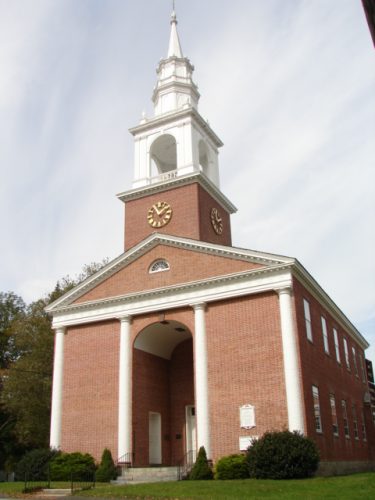 First Congregational Church
First Congregational Church
The First Congregational Church of Lebanon was organized in 1700 and built its first meetinghouse in 1706. This building was used for town meetings as well as religious services. In 1732, the meetinghouse was replaced because the original building was too small. A brick meetinghouse, designed by artist John Trumbull, was constructed 1804-1809. (Trumbull, the son of Governor Jonathan Trumbull and brother of Jonathan Trumbull Jr. grew up in Lebanon, served in the American Revolution, and became famous as the “patriot artist” of Revolutionary War scenes.) During the 19th century, the brick meeting house was up-dated several times. In 1938, hurricane winds sent the steeple toppling into the church nave, ruining the interior. Although work was interrupted by World War II, the church was fully restored by 1954.
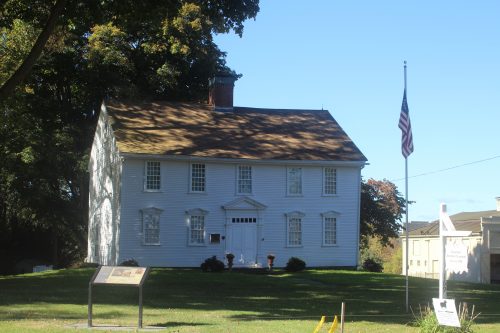 Governor Jonathan Trumbull House
Governor Jonathan Trumbull House
Merchant, Joseph Trumbull, built this house between 1735 and 1740. In 1755, on his father’s death, Jonathan Trumbull moved his family into the house, which he enlarged to suit his needs. Jonathan Trumbull carried on extensive inter-colonial and overseas trade and was politically active as a member of the General Assembly. In 1769, he was elected governor of the colony of Connecticut. A staunch opponent of British taxation, Trumbull became the only colonial governor to support the independence movement and to continue serving throughout the War for Independence. His house is now designated a National Historic Landmark as the birthplace of his son, John Trumbull, America’s patriot artist. Today it is a museum owned by the Connecticut Daughters of the American Revolution.
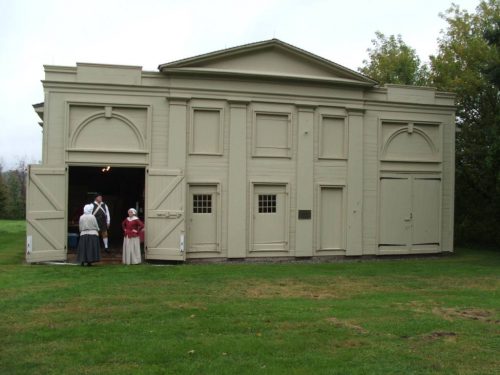 Wadsworth Stable
Wadsworth Stable
The Wadsworth Stable is located on the Governor Trumbull House grounds. The stable was originally situated on the Jeremiah Wadsworth estate in Hartford. Wadsworth, a close friend of the Trumbulls, served as commissary general of the Continental Army and later as chief agent supplying the French troops. He also hosted the first meeting between Governor Trumbull, General Washington and the French commander, the Comte de Rochambeau. The original stable on the Wadsworth property was razed in 1801 as a fire-break and a new stable in the Palladian style of architecture erected in its place. This building was moved to Lebanon in 1954 because it was threatened with demolition.
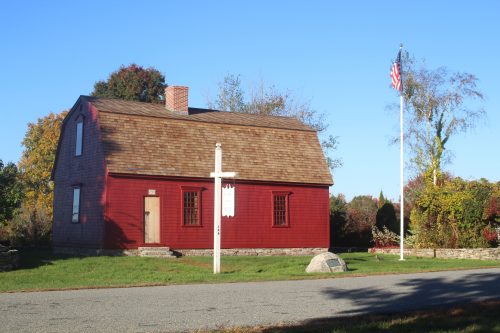 War Office
War Office
After the beginning of hostilities between the American colonies and Britain in 1775, Governor Trumbull converted his former store into his War Office. Here he met with the Council of Safety, which was empowered to manage all of the State’s affairs related to the war effort. Although the Council often met in Hartford or elsewhere, more than 500 of its 1,000 meetings took place in this building. Many important national leaders, including General George Washington, General Henry Knox, the French commander General Rochambeau, and the Marquis de Lafayette passed through its door. The War Office is now a museum owned by the Connecticut Society of the Sons of the American Revolution.
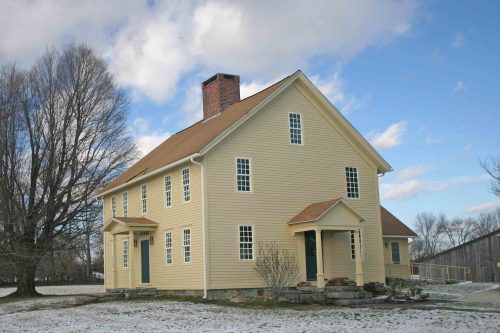 Jonathan Trumbull Jr. House
Jonathan Trumbull Jr. House
In 1777, Jonathan Trumbull Jr. purchased this house, which he and his family had been living in since 1769. Master-joiner Isaac Fitch then remodeled the interior with elaborate woodwork that remains in place today. The younger Trumbull was a Harvard graduate and a merchant dealing in whale oil, flour and ship building. When the Revolutionary War started, he served as Paymaster General for the Continental Army and the first Comptroller of the U.S. Treasury. From 1781 to 1783, he served as General George Washington’s military secretary. Later in life, he became a Congressman, U.S. Senator and Governor of Connecticut. This house is owned and operated as a museum by the Lebanon Historical Society. It is currently open for tours Friday and Saturday afternoons from 12-4 pm through the summer.
 Lebanon’s Colonial Cemeteries – Some of the finest examples of the early eastern Connecticut gravestone carving tradition can be found in three Lebanon graveyards, plus a burying ground in daughter town, Columbia. Obadiah Wheeler of Lebanon is often considered one of the best of the local carvers. There are 82 of his stones in the Trumbull Cemetery as well as stones by other carvers including John Huntington, Benjamin Collins, Lebeus Kimball, John Hartshorn and the Manning family. Many Revolutionary War era patriots are buried here, including Governor Jonathan Trumbull and William Williams, signer of the Declaration of Independence. At the rear of the Exeter Cemetery, gravestones dating back to 1720s were carved by John Huntington, the Bozrah Devil Carver, Benjamin Collins, John Johnson and others. The transition from 18th century effigy and cherub carvings to 19th century willow and urn motifs can easily be studied in this cemetery. Goshen Cemetery contains some of the best work of John Huntington and impressive stones carved by the Bozrah Devil Carver, Obadiah Wheeler, Benjamin Collins and the Manning family. Work by many of these carvers can also be seen at The Old Yard in Columbia which was part of Lebanon until 1804.
Lebanon’s Colonial Cemeteries – Some of the finest examples of the early eastern Connecticut gravestone carving tradition can be found in three Lebanon graveyards, plus a burying ground in daughter town, Columbia. Obadiah Wheeler of Lebanon is often considered one of the best of the local carvers. There are 82 of his stones in the Trumbull Cemetery as well as stones by other carvers including John Huntington, Benjamin Collins, Lebeus Kimball, John Hartshorn and the Manning family. Many Revolutionary War era patriots are buried here, including Governor Jonathan Trumbull and William Williams, signer of the Declaration of Independence. At the rear of the Exeter Cemetery, gravestones dating back to 1720s were carved by John Huntington, the Bozrah Devil Carver, Benjamin Collins, John Johnson and others. The transition from 18th century effigy and cherub carvings to 19th century willow and urn motifs can easily be studied in this cemetery. Goshen Cemetery contains some of the best work of John Huntington and impressive stones carved by the Bozrah Devil Carver, Obadiah Wheeler, Benjamin Collins and the Manning family. Work by many of these carvers can also be seen at The Old Yard in Columbia which was part of Lebanon until 1804.
Heartbeat of the Revolution letterboxing trail
Use this series of clues (found posted online at www.letterboxing.org) to follow a scavenger-hunt trail around the Green to learn about life in Lebanon at the time of the American Revolution. Each hidden box includes a stamp and ink pad so visitors can collect images as they progress. If you bring your own stamp with you, you can leave your mark in the journals in each box. A great family activity that is free and available seven days a week.
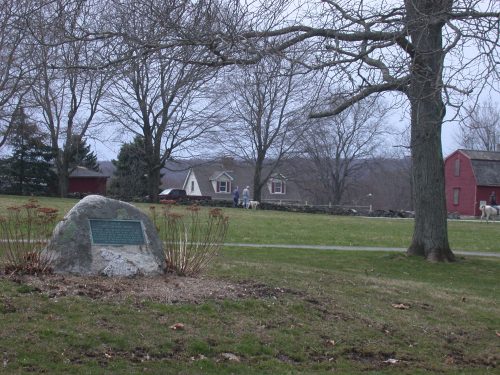 Lebanon Green Walk – Lebanon’s Green is unlike those found elsewhere in eastern Connecticut. A mile in length and with a major portion still in agricultural use, the Lebanon Green is unique because of its size, preservation and association with significant events of the American Revolution. A graded stone-dust path circles the Green, providing a pleasant easy to walk stroll. In winter, a portion of the Green is flooded for ice skating. Lebanon’s historic sites as well as the Historical Society, Town Hall and public library are all located around the Green.
Lebanon Green Walk – Lebanon’s Green is unlike those found elsewhere in eastern Connecticut. A mile in length and with a major portion still in agricultural use, the Lebanon Green is unique because of its size, preservation and association with significant events of the American Revolution. A graded stone-dust path circles the Green, providing a pleasant easy to walk stroll. In winter, a portion of the Green is flooded for ice skating. Lebanon’s historic sites as well as the Historical Society, Town Hall and public library are all located around the Green.
